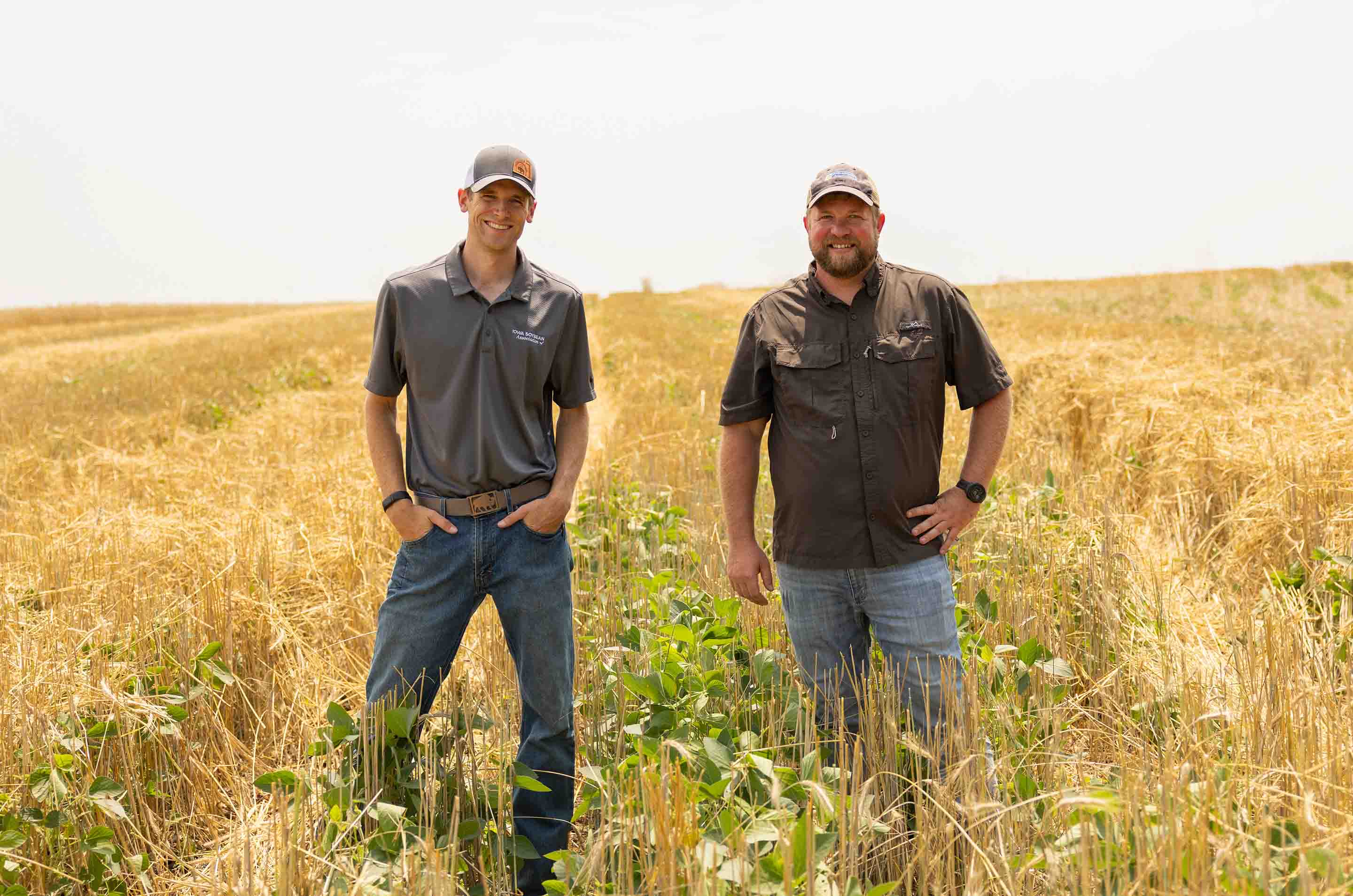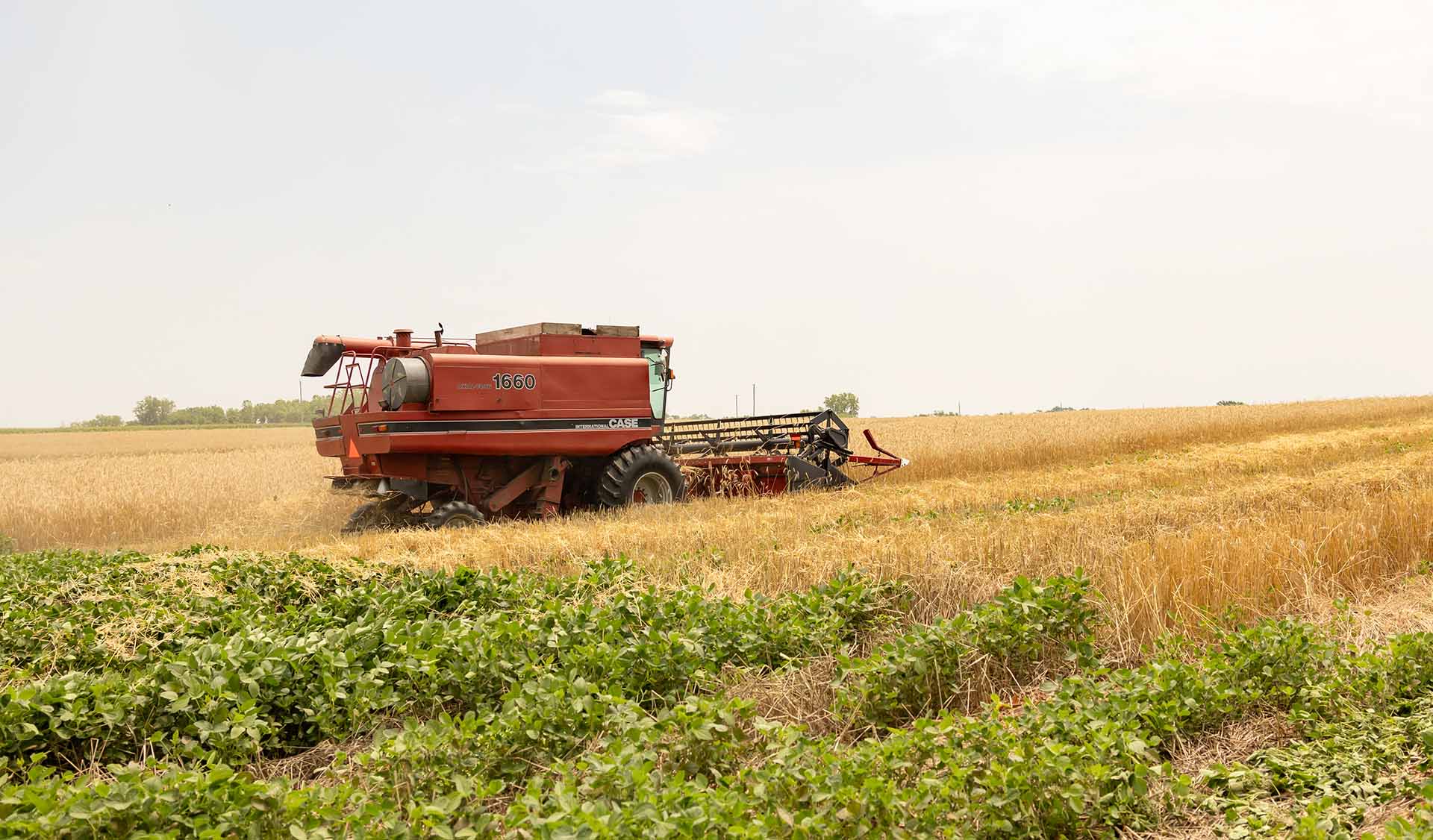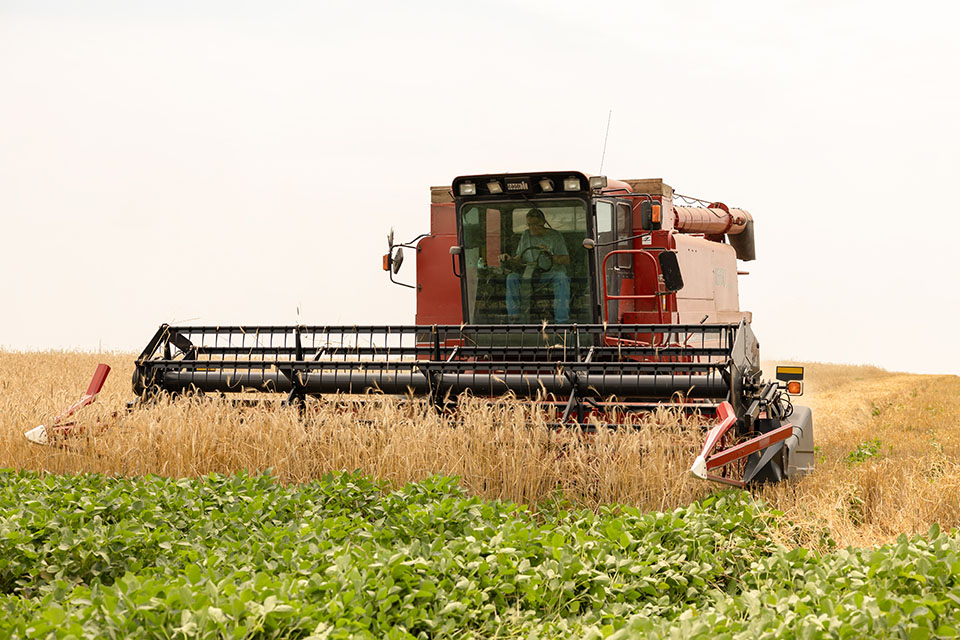
(Photo: Iowa Soybean Association / Joclyn Bushman)
Walking Rows: ISA agronomists update - July 18
July 18, 2024 | Kriss Nelson
Iowa Soybean Association (ISA) research agronomists are reporting most soybeans are reaching the reproductive stages, and crop-dusting airplanes and high-clearance sprayers are prevalent in corn fields with fungicide applications.
The team advises growers to continue scouting and to remain vigilant if diseases and insects reach an economic injury level requiring insecticide or fungicide treatments.
Drew Clemmensen – Northwest/Western Iowa
Soybeans are reaching the R1 – R3 growth stages and are looking good. Some areas are recovering from the extended saturated soils they have endured over the last few months. Disease pressures have been light in the fields that I have been in, with
frogeye leaf spot being the most common disease found.

Stay aware of fungicides and, more importantly, insecticide applications around your farms. As fields are sprayed, pests can move to adjacent fields to escape the chemistries. This could mean a field that you had previously scouted and didn’t have any pressure or wasn’t at threshold levels may now be at levels to justify an application.
Corn is in the later V stages to R1, and airplanes are abundant applying fungicides where I have traveled.
Uneven tassel emergence in fields across my travels confirms the lack of uniformity in this crop and the additional stress it endured during the early growing stages. This also creates a difficult decision in timing to apply fungicides at the VT-R1 stages, remember the last branches of the tassel must be out and not supported by a leaf to be at the VT stage.
The use of adjuvant loads before the VT timing has shown to affect ear development, therefore delaying a fungicide with an adjuvant load until you can confirm the entire field has tasseled may be beneficial in eliminating additional stress to an already stressed corn crop.
Grasshoppers and Japanese beetles can be found in most fields with some hot pockets present. Be sure you are now scouting for these pests, as they can be detrimental to a pollinating corn crop by clipping emerging silks.
Corn rootworm beetles are present in the area. Understanding where there is pressure from these pests will indicate where plant stability issues may arise first at harvest time.
Shane Beck – Northeast/Northern Iowa
There has been a lot of talk recently about applying fungicides and insecticides to corn. The planes and high-clearance sprayers will be out shortly if they are not already.
This year, we have the makings of a good disease triangle between the host and the environment. All we will need is the pathogen to complete the disease triangle. Some crops were injured early by hail, leaving open wounds for diseases to infect.

The ideal time to spray fungicides on corn would be the late R1-R2 growth stage or when the silks are turning brown. Ideal soybean fungicide application timings are around R3. This is when a pod is 3/16 inches long on one of the top four nodes. Most soybeans I have scouted are not there yet but will be soon.
Corn rootworm traps have also gone out this week. This project is a survey to examine how different products, traits and insecticides perform throughout the state. We are looking at three to five fields per county and performing counts for northern corn rootworm and western corn rootworm once per week for four consecutive weeks.
In each field, four traps will be spaced out 200 feet apart, changed out, and counted once per week. This data will help create a prediction model for next year's corn rootworm population hot spots.
Lucas DeBruin – Southeast/Eastern Iowa
Corn and soybeans are looking good in southeast Iowa.
Lots of fungicide have been going on corn for the past two weeks. Soybeans are reaching the R3 stage, and fungicide applications are beginning in my area.

Japanese beetle and rootworms are prevalent in fields, although not above thresholds. Farmers typically mix insecticides with fungicides, so I’m not too concerned about those insect pressures.
The relay crop harvest has begun, and the yields are pretty good. There was plenty of moisture for the small grains, and they yielded quite well. The beans look good, and the recent moisture from rain or dew during the past weeks has perked them up, and they are starting to fill out.

Mikaela Lawrence – Southwest/Southern Iowa
Soybeans are reaching the R2 to V5 growth stages with baby pods forming.
Corn is about R2, and later planted fields are reaching the V10 stages, thanks to the heat and moisture we have experienced over the last few weeks.
Be mindful Japanese beetle and corn rootworm can clip silks. This could explain lower yields in patches of the field at harvest time.

For fungicide applications, I advise including a mix of modes of action and not only applying a group 11 (G11) is critical since most diseases have resistance to G11.
The “pathogen triangle” could line up perfectly this year since we’ve recently had ample moisture and hot/humid conditions. I would encourage regular scouting at this point.
Growers in central D8, mainly Clarke County, experienced quarter-sized hail last week, so they are dealing with the aftermath.
I haven’t heard anything about green snapping or goosenecking in corn, but it could happen. Most soybean plants I received pictures of were almost entirely stripped of leaves.
Alex Schaffer – Central Iowa
Corn and soybeans entered the reproductive stages at the end of July and the beginning of August. This is when we hope for plenty of moisture and lower temperatures. For corn, the focus is on setting seeds and starting grain fill; optimum temperatures will benefit this process. In August, soybeans will be setting and filling pods.
Verify planting records for an accurate understanding of hybrids to ensure which fields may be more susceptible to disease and insect pressure. Understanding the distinction between offensive and defensive hybrid products is crucial. In prime conditions, offensive hybrids are more vulnerable to diseases, making them suitable for fungicide applications. On the other hand, defensive hybrids are more resilient and capable of withstanding attacks from pests throughout the season.

Be scouting for diseases in soybeans, including septoria brown spot and frogeye leaf spot. Older growth of the soybeans can show signs of septoria brown spot, while frogeye leaf spot develops on the newer leaves.
Insects, including grasshoppers, Japanese beetle and bean leaf beetle can be found feeding on newer growth in soybeans. There is some concern we could see multiple generations of insects this year due to and earlier, warm spring.
Most of the relay cropping trials were harvested last week and there have been above-average yields of small grains within those trials. The harvest timing of the small grains seems perfect as it got the soybeans out of competition, just in time to flower. Given the moisture we have had and the earlier-than-normal small-grain harvest, I am optimistic about soybean yield this year in those relay cropping fields.

Fungicide trials on soybeans will begin in the next few weeks. With the weather this season, I hope to see positive results from the fungicide.
Back